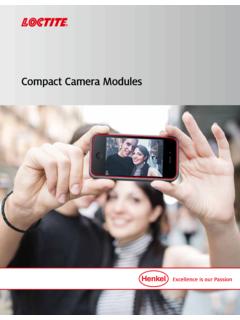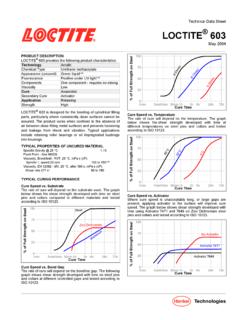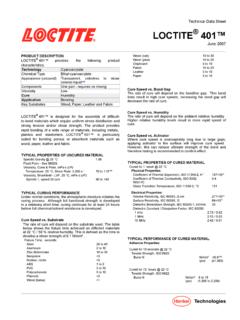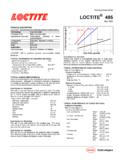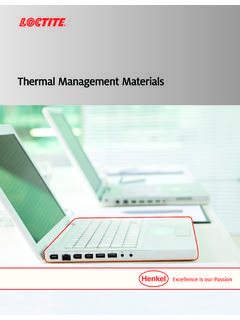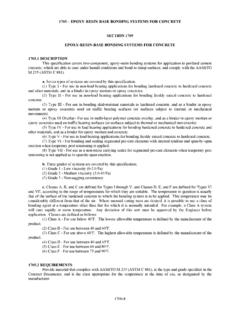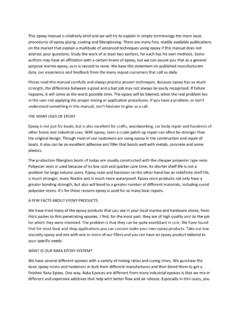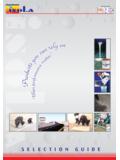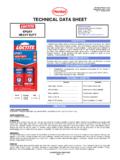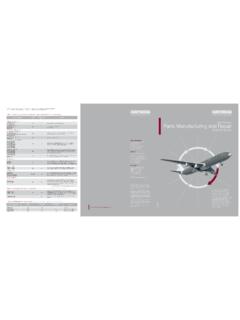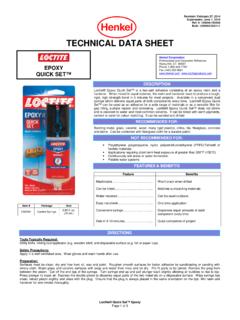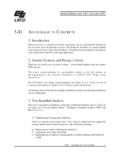Transcription of Volume 2 2/05 - LOCTITE
1 Volume 22/05 The LOCTITE Design Guide for bonding Rubbers and TPEs, Volume 21 Table Of ContentsPage NumberIntroduction2 Description Of Adhesives3 Cyanoacrylate Adhesives3 epoxy Adhesives4 Hot Melt Adhesives5 Light Curing Acrylic Adhesives6 Polyurethane Adhesives7 Silicone Adhesives8 No-Mix and Static Mix Acrylic Adhesives9 Why Bond Elastomers With LOCTITE Brand Adhesives?10 How To Use The Rubber and TPE bonding Chapters11 How to Use The Adhesive Shear Strength Table12 Rubber and TPE bonding Chapters14 Butyl Rubber (IIR)14 Chlorosulfonated Polyethylene (CSM)16 Copolyester TPE18 Epichlorohydrin Rubber (CO, ECO, GCO, GECO)20 Ethylene Acrylic Rubber (EEA)22 Ethylene Propylene Rubber (EPM, EPDM)24 Ethylene-Vinyl Acetate Copolymer (EVA)26 Fluorocarbon Rubber (FKM)28 Fluorosilicone Rubber (FVMQ)30 Halogenated Butyl Rubber (BIIR, CIIR)32 Hydrogenated Nitrile Rubber (H-NBR, HSN)34 Melt Processible Rubber (MPR)36 Natural Rubber (NR)38 Neoprene Rubber (CR)
2 40 Nitrile Rubber (NBR, XNBR)42 Polyether Block Amide (PEBA)44 Polyacrylate Rubber (ACM)46 Polyisoprene Rubber (IR)48 Polyolefin Elastomers (POE)50 Poly(propylene oxide) Rubber (GPO)52 Polysulfide Rubber (TM)54 Silicone-Modified EPDM56 Silicone Rubber (MQ, VMQ, PMQ, PVMQ)58 Styrene-Butadiene Rubber (SBR)60 Styrenic TPE (S-B-S, S-I-S, S-EB-S)62 Thermoplastic Vulcanizates (TPV)64 Adhesive Joint Design66 Test Methodology69 Index of Trade Names73 Acknowledgements76 Disclaimer76 The LOCTITE Design Guide for bonding Rubbers and TPEs, Volume 2 The ProblemFrom the discovery of natural rubber to the developmentof modern day thermoplastic elastomers (TPEs),elastomeric materials have found a wide variety of uses that make them an integral part of an industrialsociety.
3 In a diverse variety of products ranging fromautomobile tires to lifesaving implantable medicaldevices, their unique ability to be greatly deformed and return to their original shape fills an importantniche in the world of engineering materials. It would be difficult to identify a manufacturing process whichdoes not use elastomers in one form or materials have achieved widespreadacceptance due to the virtually limitless combinationsof elastomer types, fillers and additives which can becompounded at relatively low costs and processed by a wide variety of methods. This gives end-users theability to develop specific formulations with propertiestailored to their needs.
4 By properly selecting the baseelastomer, additives and fillers, as well as the appropriatecure method, the physical, chemical and thermal properties of an elastomer can be made to meet orexceed the performance requirements of almost anyapplication requiring elastomeric , while the limitless variety of elastomers is aninvaluable asset to a designer selecting an elastomer, it is the designer s biggest limitation when selecting anadhesive. The countless adhesives available, coupledwith the virtually limitless elastomer formulations possible, make it highly unlikely that there will be bond strength data for the specific adhesive/elastomer combination in the designer's SolutionBond Strength InformationThis guide is designed to indicate the bondability of the26 most commonly used families of elastomers.
5 Thiswas accomplished using two approaches. The majorityof elastomers which were evaluated were compoundedspecifically to determine the effect different additivesand fillers had on the bondability of these the designer identifies the elastomer formulationscontaining the same fillers and additives that aredesired to be bonded, the adhesives can then bepinpointed which performed best on those this will probably not tell the designer theexact bond strength that will be achieved by thatspecific adhesive on that specific material, it will givethe designer a general idea of what bond strengths canbe achieved. For the other elastomers, bond strengthtesting was performed on commercially availablegrades which were selected to represent each majorcategory of the elastomer based on the major end-useapplications, and/or the chemical structure of InformationAn adhesive cannot be selected for an applicationsolely on the basis of bond strength information.
6 Otherfactors such as the cure speed, environmentalresistance, thermal resistance, and suitability forautomation of an adhesive will play a critical role indetermining the best adhesive for a specific give a designer insight into these design parameters,an in-depth description of the seven adhesive types,namely cyanoacrylates, no-mix/static mix acrylics, hotmelts, epoxies, polyurethanes, silicones and light curingacrylics, has been included in this guide. Theseadhesive sections contain a general description of eachadhesive, a detailed discussion of the chemicalstructure and cure mechanism of each adhesive, andthe benefits and limitations of using each InformationManufacturers may have the flexibility to select theelastomers which are best suited for their applicationsin terms of performance and bondability.
7 To aid thedesigner, an in-depth discussion of each of theelastomer types is included. Information coveredincludes a general description of the elastomer and itsproperties, as well as a list of trade names, suppliersand typical Process EffectsFor thermoset rubbers, the ultimate bond strength mightbe improved by stopping the vulcanization processbefore all cross-linking sites available have beenconsumed. Stopping the vulcanization process beforethe rubber has achieved its ultimate modulus will leaveunreacted cross-linking sites on the rubber backboneand form a polymer with a lower cross-link density. As aresult, the unreacted cross-linking sites may improvebond strength by reacting with the adhesive.
8 In addition,the lower cross-link density of the rubber may facilitateadhesive penetration of the rubber polymer network. Toinvestigate this phenomenon, each of the thermosetrubbers, except the PEBA, was cured to 80% of theirultimate modulus (noted as T80 cure in the adhesiveshear strength tables), and tested for bond results were then compared with those of thecontrol for statistically significant Design InformationFinally, a manufacturer may have a design in which hedesires to incorporate an adhesively bonded joint. Toeffectively design that joint, the designer must knowwhich parameters are critical to the bond strengthsachieved by a bonded joint and the effect thatchanging these parameters will have.
9 A bond designsection which reviews the basics of designing anadhesively bonded single lap joint is included in anattempt to give the designer insight into this most real world bond geometries are morecomplex than single lap joints, this information can beextrapolated as a general indicator of the effectscaused by changing bond LOCTITE Design Guide for bonding Rubbers and TPEs, Volume 2 CyanoacrylateAdhesivesGeneral DescriptionCyanoacrylates are one-part, room-temperature-curingadhesives that are available in viscosities ranging fromwater-thin liquids to thixotropic gels. When pressed intoa thin film between two surfaces, cyanoacrylates curerapidly to form rigid thermoplastics with excellentadhesion to most substrates.
10 One of the benefits cyanoacrylates offer is theavailability of a wide variety of specialty formulationswith properties tailored to meet particularly challengingapplications. For example, rubber-toughenedcyanoacrylates offer high peel strength and impactresistance to complement the high shear and tensilestrengths characteristic of cyanoacrylates. Thermallyresistant cyanoacrylates are available which offerexcellent bond strength retention after exposure totemperatures as high as 250 F for thousands of , Surface-insensitive cyanoacrylates offerrapid fixture times and cure speeds on acidic surfaces,such as wood or dichromated metals, which could slowthe cure of a cyanoacrylate.
